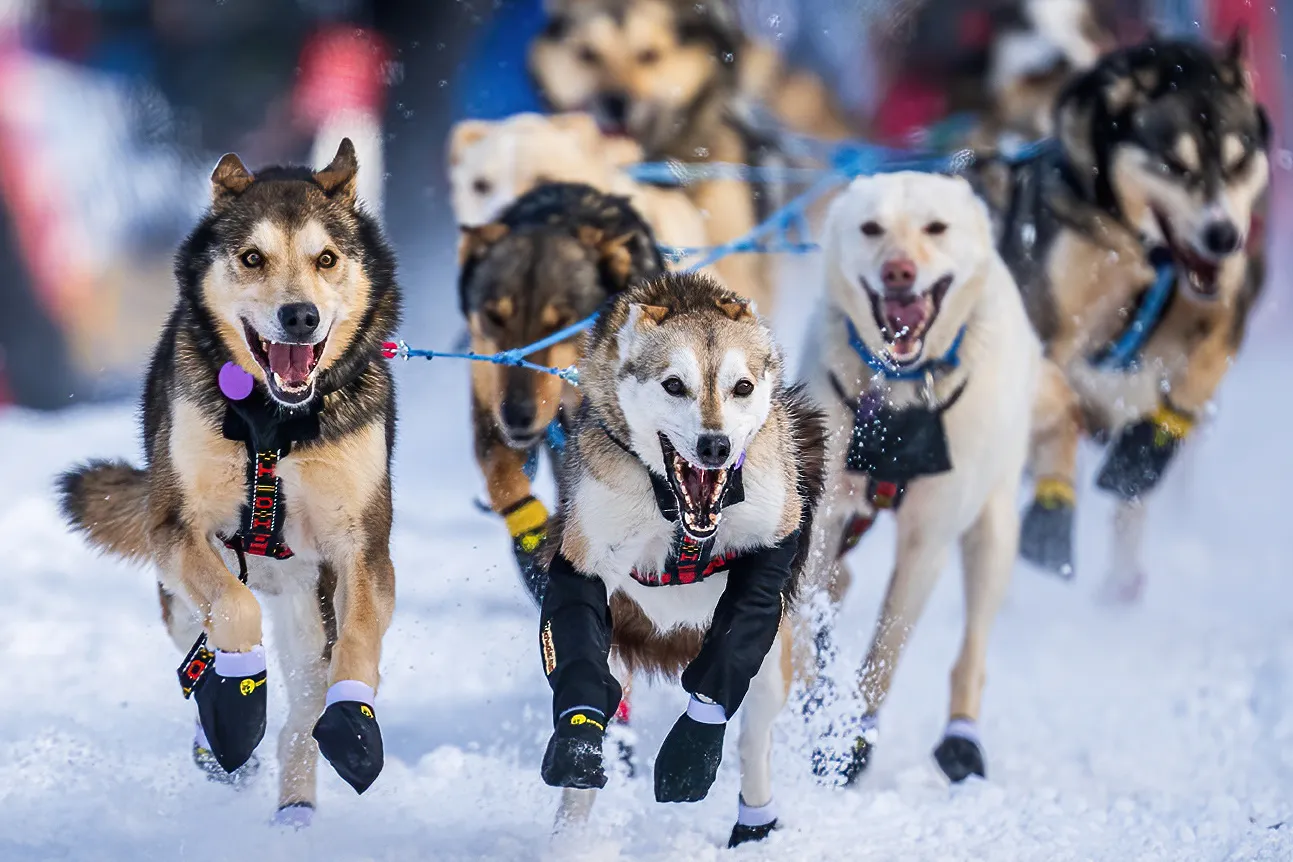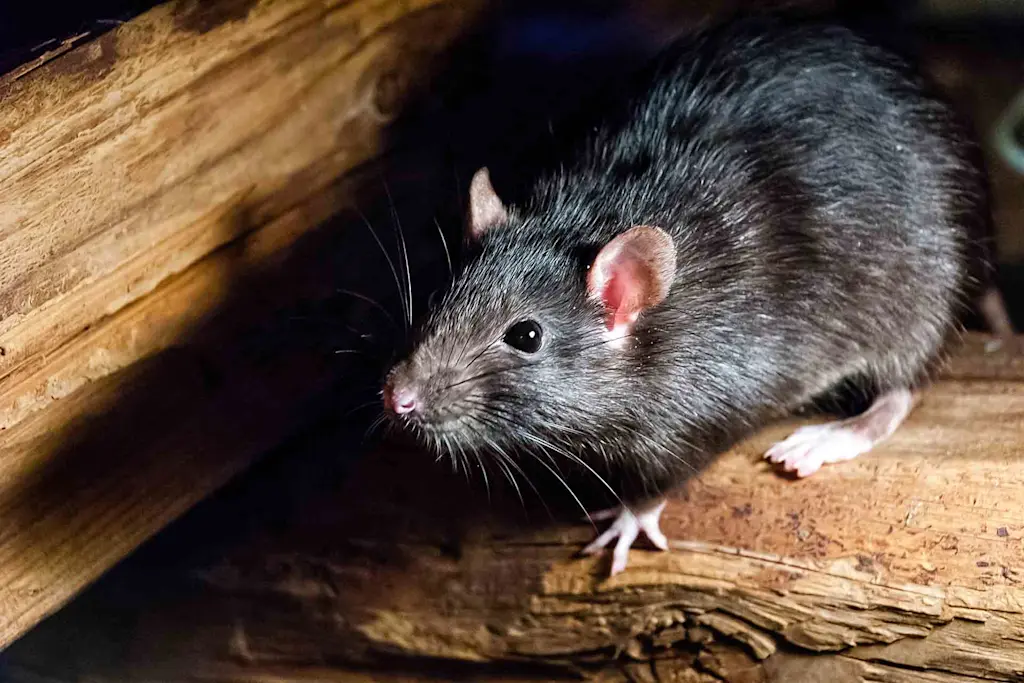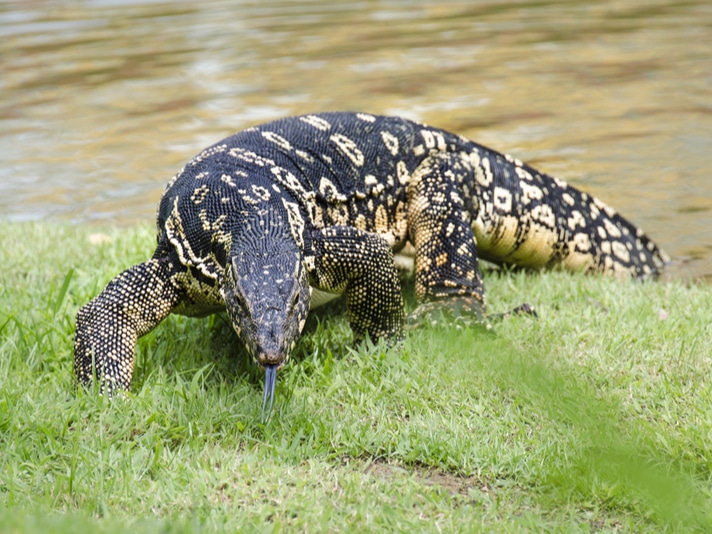Introduction to the Iditarod
The Iditarod Trail Sled Dog Race, known as the “Last Great Race on Earth,” is an annual long-distance sled dog race held in Alaska. It runs from Anchorage to Nome, covering approximately 1,000 miles (1,609 km) of rugged terrain. The race is a testament to the endurance and skill of both mushers and their sled dogs.
History of the Iditarod
The Iditarod has its roots in the early 20th century when sled dogs were used to transport mail and supplies across Alaska. The most famous event in this era was the 1925 Serum Run, where sled dogs delivered life-saving diphtheria serum to Nome during a severe outbreak. This heroic effort inspired the creation of the modern Iditarod race.
In 1967, a short sled dog race was organized as part of Alaska’s centennial celebration. This event evolved into the full-length Iditarod Trail Sled Dog Race in 1973, founded by Dorothy G. Page and Joe Redington, Sr..
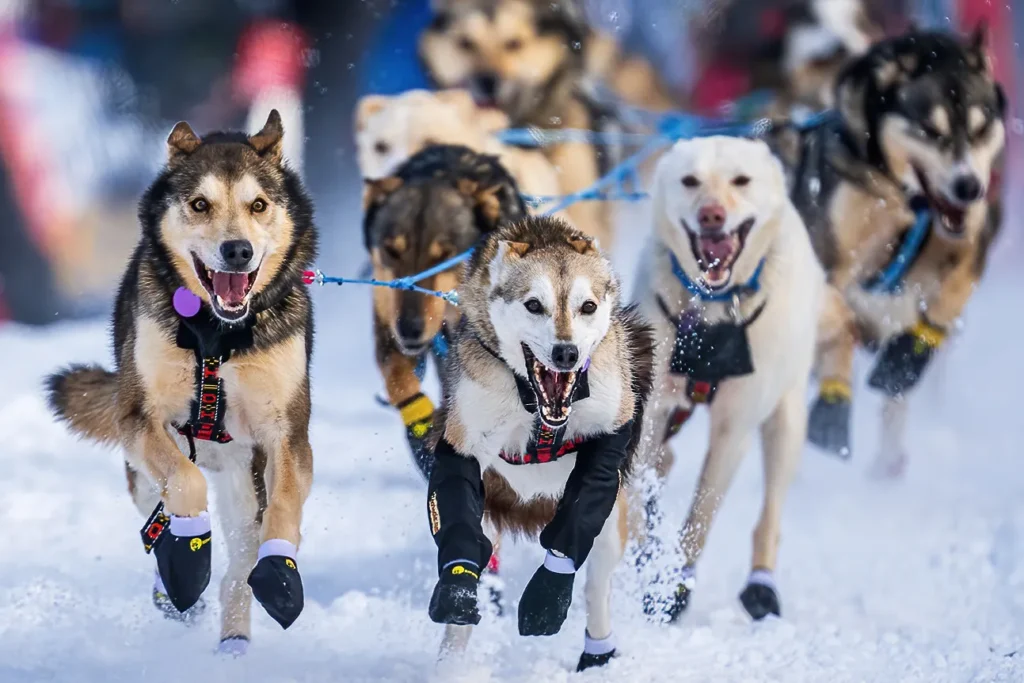
The Iditarod Route and Challenges
The race starts with a ceremonial beginning in Anchorage, followed by an official restart in Willow. The trail traverses the Alaska Range and the Kuskokwim Mountains, running along the Bering Sea to reach Nome. The route alternates between a northern and southern path each year to distribute the impact on local communities.
Mushers and their dogs face extreme conditions, including blizzards, sub-zero temperatures, and gale-force winds. The race requires teams to be highly prepared and resilient, with strategies like rest and nutrition crucial for the dogs’ health and performance.
The Jr. Iditarod
For younger enthusiasts, the Jr. Iditarod offers a similar experience. This race is designed for teenagers aged 14 to 17 and provides an opportunity for them to learn about sled dog racing, dog training, and the challenges of the trail.
Significance and Legacy
The Iditarod is not only a competitive event but also a celebration of Alaska’s history and the role of sled dogs in its development. It attracts participants from around the world and is a symbol of endurance and teamwork between humans and animals.
Educational Aspects
The Iditarod serves as a valuable educational tool, incorporating subjects like math, reading, writing, social studies, and science. It offers insights into Alaska’s history, geography, and the science behind sled dog racing.
Animal Welfare and Safety
The Iditarod has faced criticism regarding animal welfare, with concerns about dog fatalities and injuries. However, the race has implemented measures to protect the dogs, including mandatory rest stops and increased veterinary care.
Famous Mushers
Some of the most renowned mushers include Rick Swenson, Susan Butcher, Doug Swingley, and Dallas Seavey. These individuals have not only excelled in the race but have also contributed to its popularity and legacy.
The Role of Sled Dogs
Sled dogs, typically breeds like Siberian Huskies and Alaskan Malamutes, are chosen for their endurance and ability to thrive in cold conditions. Mushers train these dogs from puppyhood to prepare them for the race.
Community and Cultural Impact
The Iditarod is deeply rooted in Alaska’s culture and history, serving as a link to the state’s past. It attracts visitors and participants from around the world, contributing to local economies and promoting cultural exchange.
Conclusion
The Iditarod Trail Sled Dog Race is a remarkable event that combines adventure, history, and education. It celebrates the unique bond between humans and animals while highlighting Alaska’s rich cultural heritage.
Detailed Overview
Early Years and the Serum Run
The Iditarod’s history is closely tied to the early 20th-century use of sled dogs for transportation in Alaska. The most famous event from this era is the 1925 Serum Run, where sled dogs delivered life-saving diphtheria serum to Nome during a severe outbreak.
Founding of the Modern Iditarod
In 1967, a short sled dog race was organized as part of Alaska’s centennial celebration. This event laid the groundwork for the modern Iditarod Trail Sled Dog Race, which began in 1973.
Evolution of the Race
Over the years, the Iditarod has evolved to become more competitive and safer for the dogs. The race now includes mandatory rest stops and increased veterinary care to protect the sled dogs.
The Iditarod Route and Its Challenges
Ceremonial Start and Official Restart
The race begins with a ceremonial start in Anchorage, followed by an official restart in Willow. This setup allows for a festive beginning in the city while ensuring the race starts on suitable terrain for sled dogs.
Terrain and Conditions
The trail spans over 1,000 miles, crossing the Alaska Range and the Kuskokwim Mountains before reaching Nome along the Bering Sea. Mushers and their dogs face extreme conditions, including blizzards and sub-zero temperatures.
Animal Welfare and Safety Measures
The Iditarod has implemented several measures to protect the dogs, including mandatory rest stops and increased veterinary care. Race officials and veterinarians closely monitor the dogs’ condition throughout the race.
Famous Mushers and Their Achievements
Renowned mushers like Rick Swenson, Susan Butcher, Doug Swingley, and Dallas Seavey have excelled in the race and contributed to its popularity and legacy. Their achievements have inspired new generations of mushers and contributed to the race’s global recognition.
Conclusion
The Iditarod Trail Sled Dog Race is an extraordinary event that embodies the spirit of adventure, resilience, and teamwork. It serves as a reminder of Alaska’s rich past and the enduring bond between humans and animals. The race continues to inspire new generations of mushers and spectators alike, ensuring its place as one of the world’s most iconic sporting events.
Introduction to the Iditarod
The Iditarod Trail Sled Dog Race, known as the “Last Great Race on Earth,” is an annual long-distance sled dog race held in Alaska. It runs from Anchorage to Nome, covering approximately 1,000 miles (1,609 km) of rugged terrain. The race is a testament to the endurance and skill of both mushers and their sled dogs.
History of the Iditarod
The Iditarod has its roots in the early 20th century when sled dogs were used to transport mail and supplies across Alaska. The most famous event in this era was the 1925 Serum Run, where sled dogs delivered life-saving diphtheria serum to Nome during a severe outbreak. This heroic effort inspired the creation of the modern Iditarod race.
In 1967, a short sled dog race was organized as part of Alaska’s centennial celebration. This event evolved into the full-length Iditarod Trail Sled Dog Race in 1973, founded by Dorothy G. Page and Joe Redington, Sr..
The Iditarod Route and Challenges
The race starts with a ceremonial beginning in Anchorage, followed by an official restart in Willow. The trail traverses the Alaska Range and the Kuskokwim Mountains, running along the Bering Sea to reach Nome. The route alternates between a northern and southern path each year to distribute the impact on local communities.
Mushers and their dogs face extreme conditions, including blizzards, sub-zero temperatures, and gale-force winds. The race requires teams to be highly prepared and resilient, with strategies like rest and nutrition crucial for the dogs’ health and performance.
The Jr. Iditarod
For younger enthusiasts, the Jr. Iditarod offers a similar experience. This race is designed for teenagers aged 14 to 17 and provides an opportunity for them to learn about sled dog racing, dog training, and the challenges of the trail.
Significance and Legacy
The Iditarod is not only a competitive event but also a celebration of Alaska’s history and the role of sled dogs in its development. It attracts participants from around the world and is a symbol of endurance and teamwork between humans and animals.
Educational Aspects
The Iditarod serves as a valuable educational tool, incorporating subjects like math, reading, writing, social studies, and science. It offers insights into Alaska’s history, geography, and the science behind sled dog racing.
Animal Welfare and Safety
The Iditarod has faced criticism regarding animal welfare, with concerns about dog fatalities and injuries. However, the race has implemented measures to protect the dogs, including mandatory rest stops and increased veterinary care.
Famous Mushers
Some of the most renowned mushers include Rick Swenson, Susan Butcher, Doug Swingley, and Dallas Seavey. These individuals have not only excelled in the race but have also contributed to its popularity and legacy.
The Role of Sled Dogs
Sled dogs, typically breeds like Siberian Huskies and Alaskan Malamutes, are chosen for their endurance and ability to thrive in cold conditions. Mushers train these dogs from puppyhood to prepare them for the race.
Community and Cultural Impact
The Iditarod is deeply rooted in Alaska’s culture and history, serving as a link to the state’s past. It attracts visitors and participants from around the world, contributing to local economies and promoting cultural exchange.
Conclusion
The Iditarod Trail Sled Dog Race is a remarkable event that combines adventure, history, and education. It celebrates the unique bond between humans and animals while highlighting Alaska’s rich cultural heritage.
Detailed Overview
Early Years and the Serum Run
The Iditarod’s history is closely tied to the early 20th-century use of sled dogs for transportation in Alaska. The most famous event from this era is the 1925 Serum Run, where sled dogs delivered life-saving diphtheria serum to Nome during a severe outbreak.
Founding of the Modern Iditarod
In 1967, a short sled dog race was organized as part of Alaska’s centennial celebration. This event laid the groundwork for the modern Iditarod Trail Sled Dog Race, which began in 1973.
Evolution of the Race
Over the years, the Iditarod has evolved to become more competitive and safer for the dogs. The race now includes mandatory rest stops and increased veterinary care to protect the sled dogs.
The Iditarod Route and Its Challenges
Ceremonial Start and Official Restart
The race begins with a ceremonial start in Anchorage, followed by an official restart in Willow. This setup allows for a festive beginning in the city while ensuring the race starts on suitable terrain for sled dogs.
Terrain and Conditions
The trail spans over 1,000 miles, crossing the Alaska Range and the Kuskokwim Mountains before reaching Nome along the Bering Sea. Mushers and their dogs face extreme conditions, including blizzards and sub-zero temperatures.
Animal Welfare and Safety Measures
The Iditarod has implemented several measures to protect the dogs, including mandatory rest stops and increased veterinary care. Race officials and veterinarians closely monitor the dogs’ condition throughout the race.
Famous Mushers and Their Achievements
Renowned mushers like Rick Swenson, Susan Butcher, Doug Swingley, and Dallas Seavey have excelled in the race and contributed to its popularity and legacy. Their achievements have inspired new generations of mushers and contributed to the race’s global recognition.
Conclusion
The Iditarod Trail Sled Dog Race is an extraordinary event that embodies the spirit of adventure, resilience, and teamwork. It serves as a reminder of Alaska’s rich past and the enduring bond between humans and animals. The race continues to inspire new generations of mushers and spectators alike, ensuring its place as one of the world’s most iconic sporting events.
Introduction to the Iditarod
The Iditarod Trail Sled Dog Race, known as the “Last Great Race on Earth,” is an annual long-distance sled dog race held in Alaska. It runs from Anchorage to Nome, covering approximately 1,000 miles (1,609 km) of rugged terrain. The race is a testament to the endurance and skill of both mushers and their sled dogs.
History of the Iditarod
The Iditarod has its roots in the early 20th century when sled dogs were used to transport mail and supplies across Alaska. The most famous event in this era was the 1925 Serum Run, where sled dogs delivered life-saving diphtheria serum to Nome during a severe outbreak. This heroic effort inspired the creation of the modern Iditarod race.
In 1967, a short sled dog race was organized as part of Alaska’s centennial celebration. This event evolved into the full-length Iditarod Trail Sled Dog Race in 1973, founded by Dorothy G. Page and Joe Redington, Sr..
The Iditarod Route and Challenges
The race starts with a ceremonial beginning in Anchorage, followed by an official restart in Willow. The trail traverses the Alaska Range and the Kuskokwim Mountains, running along the Bering Sea to reach Nome. The route alternates between a northern and southern path each year to distribute the impact on local communities.
Mushers and their dogs face extreme conditions, including blizzards, sub-zero temperatures, and gale-force winds. The race requires teams to be highly prepared and resilient, with strategies like rest and nutrition crucial for the dogs’ health and performance.
The Jr. Iditarod
For younger enthusiasts, the Jr. Iditarod offers a similar experience. This race is designed for teenagers aged 14 to 17 and provides an opportunity for them to learn about sled dog racing, dog training, and the challenges of the trail.
Significance and Legacy
The Iditarod is not only a competitive event but also a celebration of Alaska’s history and the role of sled dogs in its development. It attracts participants from around the world and is a symbol of endurance and teamwork between humans and animals.
Educational Aspects
The Iditarod serves as a valuable educational tool, incorporating subjects like math, reading, writing, social studies, and science. It offers insights into Alaska’s history, geography, and the science behind sled dog racing.
Animal Welfare and Safety
The Iditarod has faced criticism regarding animal welfare, with concerns about dog fatalities and injuries. However, the race has implemented measures to protect the dogs, including mandatory rest stops and increased veterinary care.
Famous Mushers
Some of the most renowned mushers include Rick Swenson, Susan Butcher, Doug Swingley, and Dallas Seavey. These individuals have not only excelled in the race but have also contributed to its popularity and legacy.
The Role of Sled Dogs
Sled dogs, typically breeds like Siberian Huskies and Alaskan Malamutes, are chosen for their endurance and ability to thrive in cold conditions. Mushers train these dogs from puppyhood to prepare them for the race.
Community and Cultural Impact
The Iditarod is deeply rooted in Alaska’s culture and history, serving as a link to the state’s past. It attracts visitors and participants from around the world, contributing to local economies and promoting cultural exchange.
Conclusion
The Iditarod Trail Sled Dog Race is a remarkable event that combines adventure, history, and education. It celebrates the unique bond between humans and animals while highlighting Alaska’s rich cultural heritage.
Detailed Overview
Early Years and the Serum Run
The Iditarod’s history is closely tied to the early 20th-century use of sled dogs for transportation in Alaska. The most famous event from this era is the 1925 Serum Run, where sled dogs delivered life-saving diphtheria serum to Nome during a severe outbreak.
Founding of the Modern Iditarod
In 1967, a short sled dog race was organized as part of Alaska’s centennial celebration. This event laid the groundwork for the modern Iditarod Trail Sled Dog Race, which began in 1973.
Evolution of the Race
Over the years, the Iditarod has evolved to become more competitive and safer for the dogs. The race now includes mandatory rest stops and increased veterinary care to protect the sled dogs.
The Iditarod Route and Its Challenges
Ceremonial Start and Official Restart
The race begins with a ceremonial start in Anchorage, followed by an official restart in Willow. This setup allows for a festive beginning in the city while ensuring the race starts on suitable terrain for sled dogs.
Terrain and Conditions
The trail spans over 1,000 miles, crossing the Alaska Range and the Kuskokwim Mountains before reaching Nome along the Bering Sea. Mushers and their dogs face extreme conditions, including blizzards and sub-zero temperatures.
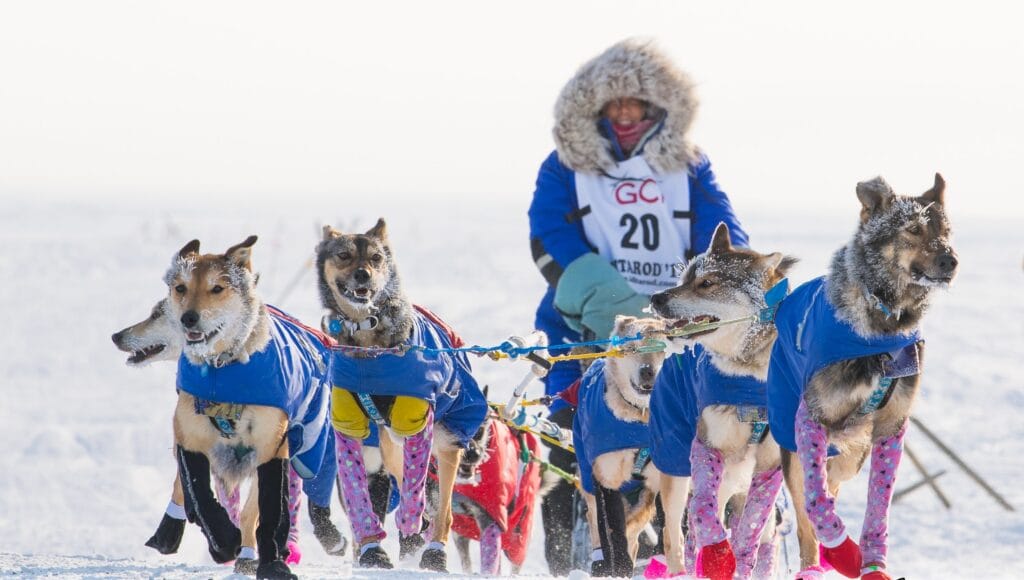
Animal Welfare and Safety Measures
The Iditarod has implemented several measures to protect the dogs, including mandatory rest stops and increased veterinary care. Race officials and veterinarians closely monitor the dogs’ condition throughout the race.
Famous Mushers and Their Achievements
Renowned mushers like Rick Swenson, Susan Butcher, Doug Swingley, and Dallas Seavey have excelled in the race and contributed to its popularity and legacy. Their achievements have inspired new generations of mushers and contributed to the race’s global recognition.
Conclusion
The Iditarod Trail Sled Dog Race is an extraordinary event that embodies the spirit of adventure, resilience, and teamwork. It serves as a reminder of Alaska’s rich past and the enduring bond between humans and animals. The race continues to inspire new generations of mushers and spectators alike, ensuring its place as one of the world’s most iconic sporting events.

